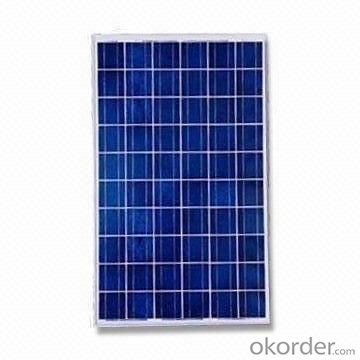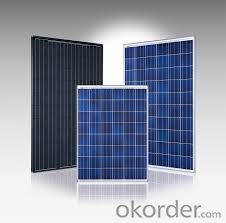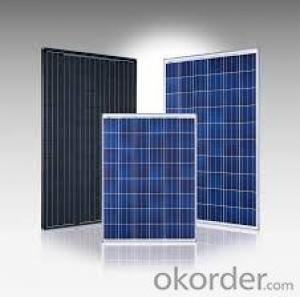Factory Directly Sale Polycrystalline solar Panel with High Quality CNBM
- Loading Port:
- Qingdao
- Payment Terms:
- TT OR LC
- Min Order Qty:
- 10 set
- Supply Capability:
- 300000 set/month
OKorder Service Pledge
OKorder Financial Service
You Might Also Like
Polycrystalline Solar Modules
CNBM offers a range of small, medium and large polycrystalline solar modules, designed for a range of requirements.


Specifications:
Tolerance | +/-3% |
Cell | Polycrystalline silicon solar cells (156 x 156mm) |
N0. of Cells | 60 (10 x 6) |
Dimension of Modules (mm) | 1650 x 990 x 40 |
Weight (kg) | 25.5 |
Limits:
Operating Temperature | -40~+85? |
Storage Temperature | -40~+85? |
Maximum System Voltage | 1000 VDC max. |
Hail Impact | Diameter of 28mm with impact speed |
Temperature and Coefficients:
NOCT | 48C+/-2? |
Voltage temperature coefficient (%/K) | -0.35 |
Current temperature coefficient (%/K) | 0.05 |
Power temperature coefficient (%/K) | -0.45 |
Characteristics:
Model: | SGM-200P | SGM-210P | SGM-220P |
Max-power voltage Vmp (V) | 29.2 | 29.4 | 29.41 |
Max-power current Imp (A) | 6.85 | 7.14 | 7.48 |
Open-circuit voltage Voc (V) | 36.5 | 36.69 | 36.9 |
Short-Circuit Current Isc (A) | 7.28 | 7.6 | 7.93 |
Max-power Pm(W) | 200 | 210 | 220 |
Model: | SGM-230P |
Max-power voltage Vmp (V) | 29.8 |
Max-power current Imp (A) | 7.72 |
Open-circuit voltage Voc (V) | 37.31 |
Short-Circuit Current Isc (A) | 8.19 |
Max-power Pm(W) | 230 |
STC: Irradiance 1000W/m2, module temperature 25?, AM-=1.5
Poly Crystalline Solar Panels Specifications Range
Maximum Power (Pm) | Dimension | Weight | Operating Voltage (Vmp) | Operating Current (Imp) | Open Circuit Voltage (Voc) | Short Circuit Current (Isc) |
0.45W | 140x80x10mm | 0.08kg | 3.3V | 150mA | 4.6V | 160mA |
1.0W | 162x140x10mm | 0.16kg | 7.5V | 150mA | 10.3V | 160mA |
4.5W | 269x251x23mm | 0.8kg | 16.5V | 0.27A | 20.5V | 0.3A |
10W | 420.1×268.9×22.6mm | 1.92kg | 17.5V | 0.58A | 20.5V | 0.6A |
20W | 425x502x50mm | 3.0kg | 16.8V | 1.19A | 21.0V | 1.29A |
30W | 593x502x22.6mm | 3.9kg | 16.8V | 1.78A | 21.0V | 1.94A |
40W | 655x537x50mm | 5.75kg | 17.3V | 2.31A | 22.1V | 2.54A |
50W | 839x537x50mm | 6.0kg | 17.5V | 2.9A | 21.8V | 3.17A |
65W | 1111x502x50mm | 7.2kg | 17.6V | 3.69A | 22.1V | 3.99A |
80W | 1204x537x50mm | 7.7kg | 17.6V | 4.55A | 22.1V | 4.8A |
- Q:What is the impact of solar cells on reducing energy inequality?
- Solar cells have a significant impact on reducing energy inequality by providing access to clean and affordable energy for communities that lack reliable electricity sources. Solar power eliminates the dependence on fossil fuels, which are often expensive and inaccessible for marginalized populations. By harnessing the sun's energy, solar cells offer a sustainable and renewable solution, empowering underserved regions and bridging the energy gap between developed and developing countries.
- Q:Can solar cells be used for powering electric vehicles in motion?
- Yes, solar cells can be used for powering electric vehicles in motion.
- Q:Can solar cells be used in greenhouses or agricultural facilities?
- Yes, solar cells can be used in greenhouses or agricultural facilities. Solar panels can be installed on the roofs or walls of these structures to harness the sunlight and convert it into electricity. This renewable energy source can power various operations such as lighting, ventilation, irrigation systems, and even machinery, reducing reliance on fossil fuels and promoting sustainability in the agricultural sector. Additionally, solar cells can help offset energy costs and enhance the overall environmental friendliness of these facilities.
- Q:Can solar cells be used in commercial buildings?
- Yes, solar cells can be used in commercial buildings. In fact, many commercial buildings worldwide are increasingly incorporating solar panels to generate renewable energy and reduce their reliance on traditional power sources. This not only helps businesses save on electricity costs but also contributes to a more sustainable and environmentally friendly operation.
- Q:Can solar cells be used underwater?
- No, solar cells cannot be used underwater as they rely on sunlight to generate electricity.
- Q:Are there any library or exhibition halls where I can show students at school how the solar cells works?
- Why don't you arrange a tour to the solar cell library in downtown?
- Q:How are solar cells made?
- Solar cells are typically made using a process called photovoltaic manufacturing, which involves several steps. First, silicon, which is the main material used in solar cells, is extracted from silica, a component of sand. The extracted silicon is then purified and transformed into a crystal structure suitable for solar cell production. These silicon wafers are then cut into thin slices. Next, various layers of conductive materials and anti-reflective coatings are applied to the wafer, creating the necessary electrical properties and enhancing light absorption. Finally, electrical contacts are added to the cell, allowing the generated electricity to be collected and used.
- Q:Does the solar cell generate electricity in the absence of the sun, only in the case of strong lights or lasers? If you can achieve how much, and the same day?
- Sunlight is a composite light, in which only the frequency is greater than the solar cell threshold photons can effectively stimulate the solar cell power generation.
- Q:What materials are commonly used to make solar cells?
- Silicon is the most commonly used material for making solar cells. Other materials, such as cadmium telluride, copper indium gallium selenide, and perovskite, are also used in certain types of solar cells.
- Q:Can solar cells be used in powering remote weather stations?
- Yes, solar cells can be used to power remote weather stations. Solar cells are a sustainable and efficient way to generate electricity, making them ideal for remote locations where access to grid power is limited. They can provide a reliable source of power for weather stations, allowing them to operate continuously and gather data even in remote areas.
1. Manufacturer Overview |
|
|---|---|
| Location | |
| Year Established | |
| Annual Output Value | |
| Main Markets | |
| Company Certifications | |
2. Manufacturer Certificates |
|
|---|---|
| a) Certification Name | |
| Range | |
| Reference | |
| Validity Period | |
3. Manufacturer Capability |
|
|---|---|
| a)Trade Capacity | |
| Nearest Port | |
| Export Percentage | |
| No.of Employees in Trade Department | |
| Language Spoken: | |
| b)Factory Information | |
| Factory Size: | |
| No. of Production Lines | |
| Contract Manufacturing | |
| Product Price Range | |
Send your message to us
Factory Directly Sale Polycrystalline solar Panel with High Quality CNBM
- Loading Port:
- Qingdao
- Payment Terms:
- TT OR LC
- Min Order Qty:
- 10 set
- Supply Capability:
- 300000 set/month
OKorder Service Pledge
OKorder Financial Service
Similar products
New products
Hot products
Related keywords


























